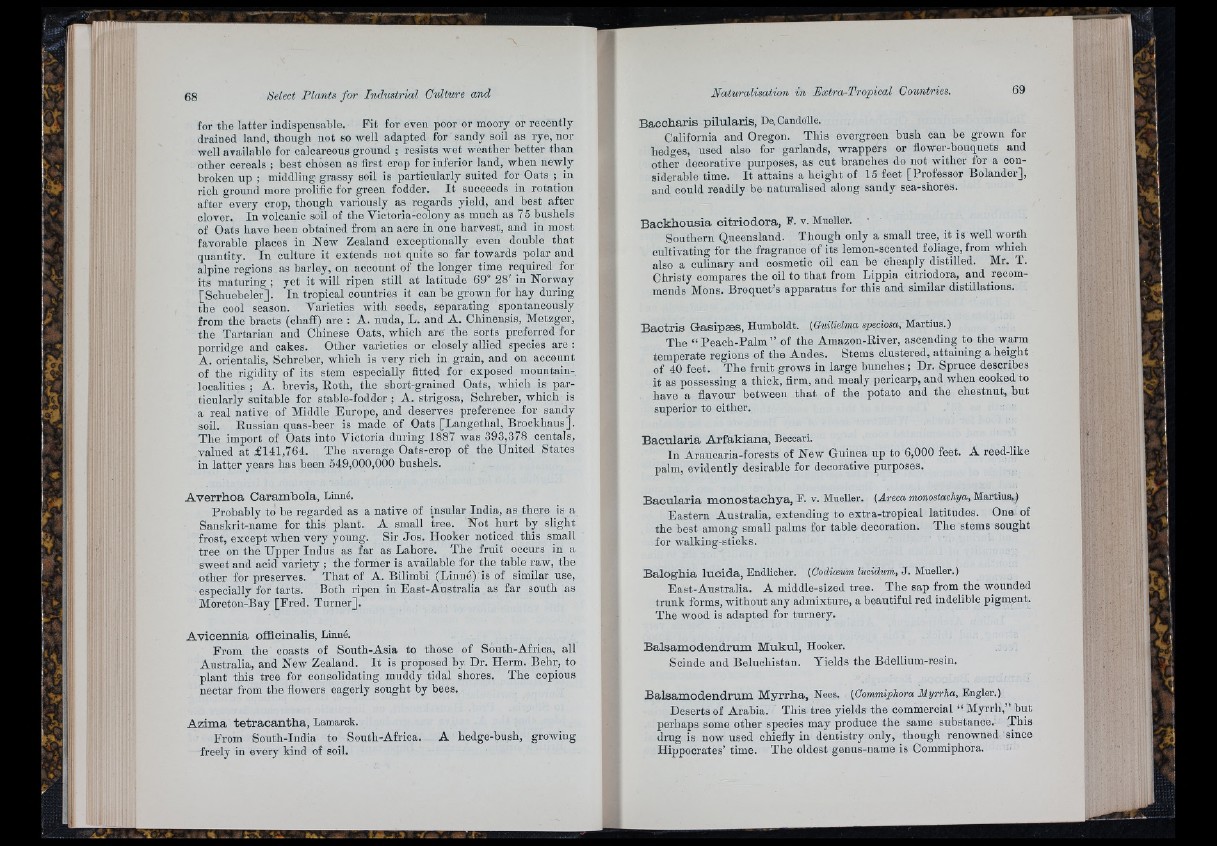
for the latter indispensable. Fit for even poor or moory or recently
drained land, though not so well adapted for sandy soil as rye, nor
well available for calcareous ground ; resists wet weather better than
other cereals ; best chosen as first crop for inferior land, when newly
broken up ; middling grassy soil is particularly suited for Oats -, in
rich ground more prolific for green fodder. I t succeeds in rotation
after every crop, though variously as regards yield, and best after
clover. In volcanic soil of the Victoria-colony as much as 75 bushels
of Oats have been obtained from an acre in one harvest, and in most
favorable places in N ew Zealand exceptionally even double th a t
quantity. In culture it extends not quite so far towards polar and
alpine regions as barley, on account of the longer time required for
its maturing ; yet it will ripen still at latitude 69° 28' in Norway
[Schuebeler]. In tropical countries it can be grown for hay during
the cool season. Varieties with seeds, separating spontaneously
from the bracts (chafi) are : A. nuda, L. and A. Chinensis, Metzger,
the Tartarian and Chinese Oats, which are the sorts preferred for
porridge and cakes. Otlier varieties or closely allied species are :
A. orientalis, Schreher, which is very rich in grain, and on account
of the rigidity of its stem especially fitted for exposed mountain-
localities ; A. brevis, Roth, the short-grained Oats, wliicli is particularly
suitable for stable-fodder ; A. strigosa, Schreher, which is
a real native of Middle Europe, and deserves preference for sandy
soil. Russian quas-beer is made of Oats [Langethal, Brockhaus].
The import of Oats into Victoria during 1887 was 393,378 centals,
valued at £141,764. The average Oats-crop of the United States
in latter years has been 549,000,000 bushels.
A v e r rh o a C a ram b o la , Linné.
Probably to be regarded as a native of insular India, as there is a
Sanskrit-name for this plant. A small tree. Not hurt by sliglit
frost, except when very young. Sir Jos. Hooker noticed this small
tree on the Upper Indus as far as Lahore. The fruit occurs in a
sweet and acid variety ; the former is available for the table raw, the
other for preserves. Th at of A. Biiimbi (Linné) is of similar use,
especially for tarts. Both ripen in East-Australia as far south as
Moreton-Bay [Fred. Turner].
A v ic e n n ia offlcinaRs, Linné.
From the coasts of South-Asia to those of South-Africa, all
Australia, and New Zealand. I t is proposed by Dr. Herm. Behr, to
plant this tree for consolidating muddy tidal shores. The copious
nectar from the flowers eagerly sought by bees.
A z im a t e t r a c a n th a , Lamarck.
From South-India to South-Africa.
freely in every kind of soil.
A hedge-hush, growing
B a c c h a r is p ilu la n is , De. Candolle.
California and Oregon. This evergreen bush can be grown for
hedges, used also for garlands, wrappers or flower-bouquets and
other decorative purposes, as cut branches do not wither for a considerable
time. I t attains a height of 15 feet [Professor Bolander],
and could readily be naturalised along sandy sea-shores.
B a o is h o u s ia c it r io d o r a , P. v. Mueller. ■
Southern Queensland. Though only a small tree, it is well worth
cultivating for the fragrance of its lemon-scented foliage, from which
also a culinary and cosmetic oil can be clieaply distilled. Mr. T.
Christy compares the oil to th a t from Lippia citriodora, and recommends
Mons. Broquet’s apparatus for this and similar distillations.
B a c tris Gasipees, Humboldt. [Guilielma speciosa, Martius.)
The “ Peach-Palm ” of the Amazon-River, ascending to the warm
temperate regions of the Andes. Stems clustered, attaining a height
of 40 feet. The fruit grows in large bunches ; Dr. Spruce describes
it as possessing a thick, firm, and mealy pericarp, and when cooked to
have a flavour between that of the potato and the chestnut, hut
superior to either.
B a c u la r ia A rfa k ia n a , Becoari.
In Arauoaria-forests of New Guinea up to 6,000 feet. A reed-like
paim, evidently desirable for decorative purposes.
B a c u la r ia m o n o s ta c h y a , F. V. Mueller. (Areca monoslachya, Martius.)
Eastern Australia, extending to extra-tropical latitudes. One of
the best among small palms for table decoration. The stems sought
for walking-sticks.
B a lo g h ia lu c id a , Endlicher. (Godiaum lucidwm, J. Mueller.)
East-Australia. A middle-sized tree. The sap from the wounded
trunk forms, w ithout any admixture, a beautiful red indelible pigment.
The wood is adapted for turnery.
B a ls am o d e n d rum M u k u l, Hooker.
Scinde and Beluchistan. Yields the Bdellium-resin.
B a ls am o d e n d rum M y r rh a , Nees. (Gommiphora Myrrha, Engler.)
Deserts of Arabia. This tree yields the commercial “ Myrrh,” but
perhaps some other species may produce the same substance. This
drug is now used chiefly in dentistry only, though renowned since
Hippocrates’ time. The oldest genus-name is Commiphora.